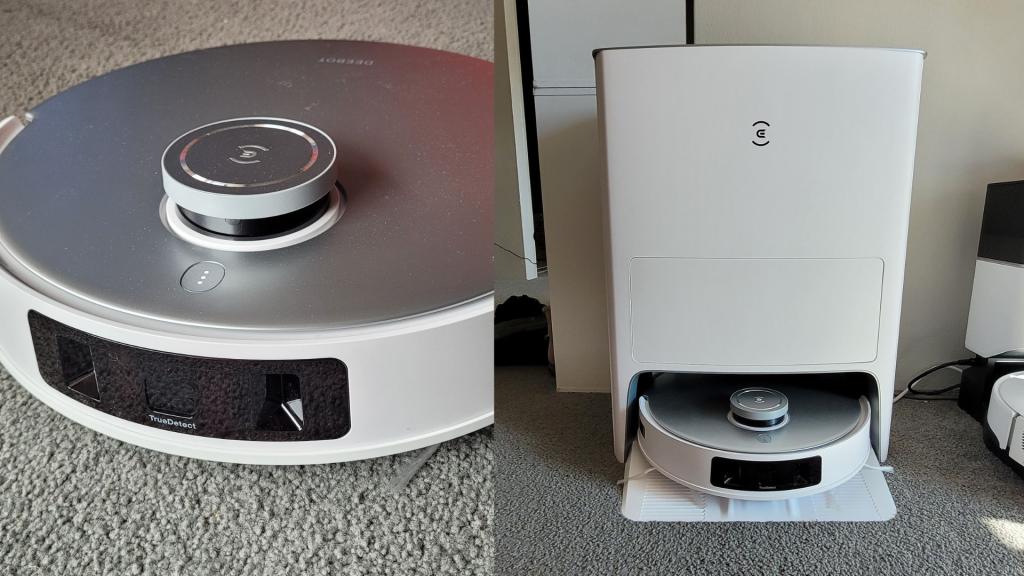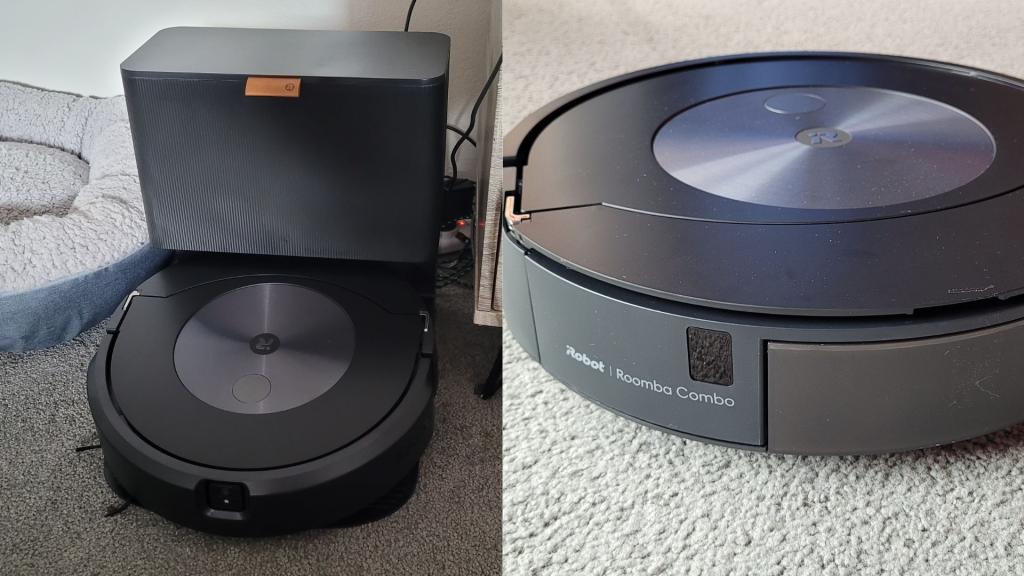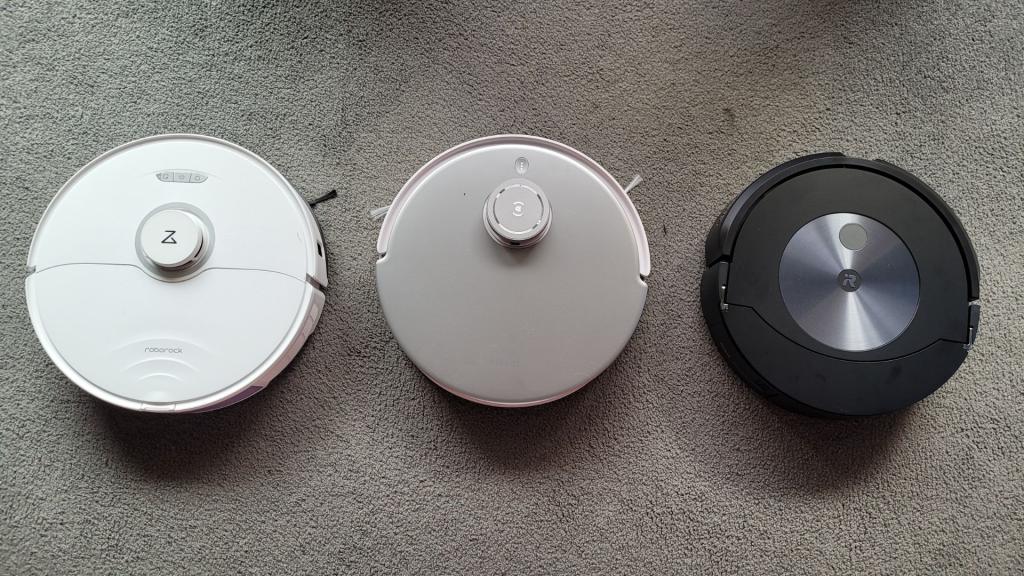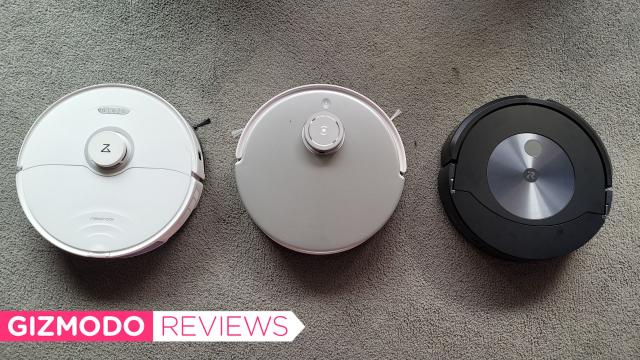The biggest and hottest smart home gadget right now is, undoubtedly, the robot vacuum. For those who’ve yet to acquire a robot vacuum, or are hoping to replace their current one, it’s understandable that you might struggle to identify which robovac is best suited for your home and your lifestyle. To help you out, we’ve grabbed the latest models from top robot vacuum brands – ECOVACS, iRobot and Roborock – and pitted them against each other to learn who’s really doing the most right now.
For the purposes of this comparison piece, I’ve used Roborock’s mid-ranged S8+ model, ECOVACS’ newly released DEEBOT T20 OMNI and iRobot’s Roomba Combo j7+.
Each robot vacuum can suck, mop and self-empty, however there are a few differences in features that separate them and ultimately play a part in determining each one’s price tag. While I have done my best to evaluate these models as fairly as possible, I’ve chosen to focus on the shared functions of all three, while avoiding referencing the features that are unique to reach respective device.
Table of contents
Roborock vs ECOVACS vs iRobot Specs
| SPECS | Roborock S8+ | ECOVACS DEEBOT T20 OMNI | iRobot Roomba Combo j7+ |
|---|---|---|---|
| Release date | May 2023 | July 2023 | October 2023 |
| Suctioning power | 6,000Pa | 6,000Pa | Undisclosed |
| Battery capacity | 5,200mAh Lithium Ion | 5,200mAh Lithium Ion | 2,410mAh Lithium Ion |
| Dustbin | 2.5L capacity, up to seven weeks | 3L capacity, up to 10 weeks | 2.25L, up to eight weeks |
| Features | Dual rubber brushes, carpet boost+ system, sonic-vibrational mopping, self-emptying, reactive 3D structured light and infrared imaging technology, LiDAR navigation system, No-Go zones, custom cleaning routines, supports off-peak charging. | Sucking, self-emptying, turbo rotating mopping system detachable mopping pads, hot water mop washing, 9mm liftable mop, voice assistant compatible, uses real-time 3D scanning. | Vacuuming, first-of-its-kind retractable mop, self-emptying, voice control. |
| Weight | 9.29 kg (incl. Rockdock) | 4.4 kg | 3.18 kg |
| Run time | Up to 180 mins | Up to 260 mins | Approx. 90 mins |
| Price | $1,899 | $1,799 | $2,199 |
Best design

First up on the design front is ECOVACS‘ newest robot vacuum and I have to admit, I’m pretty blown away by how good it looks. Its complementary white and silver colour scheme really pops in the home and makes it look very swish. No photo can do it justice.
As for the auto-emptying station, it looks neat and tidy, with well-hidden and seamless storage drawers that keep it nicely presented.
I was concerned about scratching the front bumper of the T20 OMNI, as this has happened to every ECOVACS’ robot vacuum I’ve reviewed in the past. So far, the T20 OMNI hasn’t done this, but that may be more of a testament to its improved navigational capabilities than the durability of its outer shell.

In comparison, the Roborock‘s white, flying saucer-esque design looks cheap compared to ECOVACS’ OMNI T20. While it does look simplistic and clean, there’s something about the white casing that doesn’t belie its $1,899 price tag.
Its dock is much more compact and more space-efficient compared to most models. Of course, if you were to upgrade to the Roborock S8 Pro Ultra, you’d be treated to a docking station that heavily resembles the T20 OMNI’s.
In terms of design, Roborock and ECOVACS’ robot vacuums appear almost identical at a glance. Aside from the colour scheme, both robots are similar in width, height and feature sensors located in the same spots. If you look closer, you will see a few differences, mainly in terms of its mopping unit – the Roborock features a built-in water tank, while this ECOVACS model has removable mopping pads that are wetted when it docks at its station.
In addition, the Roborock vac has three buttons located on the top of its body that function as a quick on/off switch, as well as a child lock and instant mopping button. ECOVACS’ has just one, which is used to switch the robot on and off.

In contrast, the iRobot’s j7+ robot vacuum is much more robust and far more unique in terms of its design. It’s black, lacks a sensor on the top of its head and is admittedly more clunkier to pick up and move around. There is also one button located towards the centre of its head, which serves as an on/off switch, of course.
Its dock has next to no frills, even as the most advanced robot vacuum cleaner in iRobot’s range. The lid sports a faux leather tab that can be used to check on the dust bags, as well as store any spares. It’s a decent size that doesn’t take up a considerable amount of space like the T20 OMNI, but appears more balanced unlike the Roborock S8+.
Best robot vacuum: In terms of design, the ECOVACS DEEBOT OMNI T20 is the clear winner here. While I’m not personally a fan of its hulking big charging station, the robot vacuum itself looks stunning as it mills about my home. It looks expensive, because it is, and much less like a piece of tech than it does as a home appliance.
Best suction power and emptying process

Onto the most important feature. In terms of suction, the Roborock S8+ is a speedy and efficient robot vacuum that leaves fluffy, deep track marks through my carpets. It never misses a spot and does an excellent job at getting into hard-to-reach spots such as corners, even expertly weaving in and around my dining table’s legs. The emptying process is quite seamless, fairly quiet and smooth.
Next is the ECOVACS DEEBOT OMNI T20, which shares the same 6,000Pa suction power as the Roborock S8+. While it definitely works just as efficiently, the result is not as noticeable on carpet as it is with the S8+, yet more evident than what I’m going to describe with the iRobot shortly.
Furthermore, the OMNI T20’s cleaning process is relatively quiet, and much less obtrusive compared to the Roborock S8+. As for its emptying process, the T20 only empties when its internal dustbin is full, and it’s surprisingly large, translating to a lower number of times you’re subjected to the loud emptying process.
And lastly, how does iRobot’s j7+ compare? Well, it’s safe to say that the iRobot does suck (in a good way), however, it’s nowhere near as powerful as ECOVACS’ or Roborock’s latest models. It appears to sit at a lower suctioning power that’s not as well-suited to homes with heavily carpeted areas such as mine.
It still gets the job done, however, and has a tendency to move from area to area in the blink of eye, occasionally leaving rooms unfinished and beginning the next one before looping back around.
As for the emptying process, well, it’s not so great. The sound is almost deafening, especially if you’re nearby, and can be heard from the opposite side of my apartment. Because the j7+ doesn’t have a large internal dustbin, it also treks back to its charging station more frequently during each cleaning cycle, resulting in multiple exposures to its noisy emptying process.
Furthermore, the j7+ struggled to automatically empty itself within a few goes. Its sensors repeatedly told me in-app that they needed maintenance, so I had to clean it more regularly than I’ve had to with the S8+ and the OMNI T20. In addition, it also became repeatedly jammed with dust bunnies and cat fur, so I often had to take it apart and clean it all out. From what I can tell, the channel that pushes the dirt out from the robot vacuum and into the tower is quite narrow, resulting in the need for more frequent maintenance.
Best robot vacuum: Roborock S8+. Nothing quite beats its suctioning prowess and efficiency.
Best mopping capabilities

When it comes to mopping, I’m often sceptical and my hesitancy is often backed up by each robovac’s lacklustre attempt. However, I was met with some promising results.
The Roborock S8+ requires a plate to be attached with a velcro tacked-on pad in order to be converted into its mopping mode. Once installed, the robot will run around sucking and wiping the floor with its mopping pad. Even on the highest scrub intensity, it does little to remove stains, especially those that have already dried.
It leaves the barest amount of water even when selecting a high water flow and doesn’t really appear to have made much of a difference to my kitchen floor.
The next robot mop I tested was iRobot’s j7+. For most robot vacuums, you need to install some kind of plate (or two) onto the bottom of it to transform it into mopping mode. However, iRobot simply requires you to press on a microfibre mopping pad beneath its lid and off it goes.
Once it comes into contact with a hard surface, its retractable mop will unfold itself to clean your floors. The idea itself is the first of its kind and revolutionary, leaving no risk of snail trails on your carpets and it works incredibly accurately.
The j7+ knows exactly when its encountered a different surface, immediately retracting its mop. The movement itself is smooth and efficient, taking mere seconds to go from vacuum mode to mop mode.
It’s only shortcoming is that the mopping itself isn’t all that top notch. Like the Roborock S8+, it merely wipes over the floor, producing little to no water in its wake. Dried stains didn’t budge an inch.
In contrast, ECOVACS’ OMNI T20 requires you to clip on two revolving mopping pads that, once installed, will automatically elevate up to 9mm when the robot encounters any carpet.
During my initial attempt, I endured snail trails all over my carpets. However, after playing around with the settings, I eventually got the robot to lift its mop, thus preventing further wet carpet trails throughout my house.
When it came to the actual mopping process, I was pleasantly surprised by how efficiently it sucked up and scrubbed away any hours-old stains on the floor. While the other robots failed to defeat my test (the test being bits of dried out wet food that my cat loves to drop and eat off the tiles), the T20 OMNI succeeded. It took two rounds, but after some heavy water flow and scrubbing, the area surrounding my cat’s feeding bowls became squeaky clean.
Best robot vacuum for mopping: You can’t knock the T20 OMNI‘s usefulness in terms of removing dried stains. But an honourable mention to iRobot’s Roomba Combo j7+. It knows what it’s doing with its carpet detection technology and its overhead retractable mop is genius, which counteracts any possibility of dreaded snail trails.
Best app and floor mapping
After setting up each of these robot vacuums, I was pleasantly surprised to find that each app is unique with various layouts.

The Roborock app possesses a quick start screen, where you can instantly select from a number of customised routines to begin your next cleaning session. Whether that’s by automatically beginning a full house clean or a select room clean, it’s a mighty handy feature to have since I could just open the app, hit clean and lock my phone.
If you want to adjust its settings further or give more specific instructions, you can hit Enter and arrive at a detailed backend with a pre-generated map of your home and plenty of settings to toy with. For instance, you can select a room or even a specific zone for the S8+ to attend to, while also customising its suction power, scrub intensity and route.
More settings allow you to manage maps (which is helpful for multi-level homes), set schedules as well as customise its reactive obstacle avoidance, carpet, auto-empty and floor cleaning settings. The attention to detail is outstanding in the Roborock app, letting you decide what kind of suctioning power to use on your carpets, how it empties its dustbin and even the way it navigates to avoid interfering pets.
Perhaps its most useful feature is “Pin n Go”, which allows you to select any random point on your floor map and direct the robot vacuum to clean that specific spot. It’s a handy feature if you’re in a rush and you’ve just spotted a bunch of crumbs under your dining table, but don’t have the time to clean it up yourself.
The app also has a cleaning history, so you can see which areas it cleaned and how much dust it collected, as well as a maintenance log that lets you know how far away each of your accessories are from replacement. If you’re well-versed with robot vacuums, you’ll know that you eventually have to replace its filter or its side brushes every so often, so Roborock’s app is a helpful reminder to ensure that each accessory is kept up-to-date to maintain the robot vacuum’s efficiency as time goes on.

As for iRobot, it has perhaps the simplest app to use that isn’t as beefed up with endless customisation options and is probably better suited to those who just want a robot vacuum that runs.
When you open the app, the screen you’re presented with is all you’ve got, allowing quick access to your schedules and the robot’s cleaning history. Like Roborock, it has its own iteration of a maintenance log, dubbed “Product Health”, which gives you the same countdown of hours before you need to replace its brushes or filters.
However, the customisation aspect is not as customisable. Instead, iRobot’s app notifies you when it detects areas in your house that are subjected to more dirt and dust than others (e.g. your dining table). The app will then make suggestions that will improve its cleaning process within these areas, but not to the extent that Roborock does in terms of letting you up the suction power to a precise level.
Its mapping, on the other hand, was the most accurate out of the three. As you can see above, it created clearly defined walls for each of the rooms without leaving glitchy patches in every direction.

Like the Roborock app, the ECOVACS app has a similar quick start screen that lets you see the robot’s battery level and status at a glance, as well as giving you the option to begin an automatic clean or send it back to the recharging station.
In the backend, you’re given the option to view a 2D or 3D map of your home, along with the option to set a number of custom cleaning schedules and processes. There’s a diverse number of customisation options, from altering the suction intensity to number of cleaning times and commands for the OMNI station.
Everything is straightforward and detailed in terms of set-up, however the mapping process is not as clear-cut or defined as iRobot’s. While you do have the option to fine-tune the map by adding furniture or altering flooring material, I noticed that it didn’t quite accurately map my home. It got several rooms incorrect and at times reported that some rooms were divided into two, when there was one. My attempts to correct the map were unachievable, whether it was trying to move walls or combining rooms. I did have to remap my apartment three times, with only subtle improvements.
Best robot vacuum: In terms of mapping, the iRobot takes the cake, but when it comes to customisation in-app, the winner is Roborock by a smidge. Its map is slightly more lenient when it comes to altering in comparison to ECOVACS, but it also offers a plethora of ways to customise your clean to your preference.
Best navigation and obstacle avoidance

The Roborock S8+ is an immensely clever robot that not only has excellent obstacle avoidance technology, but does an impeccable job dodging cables. I have far too many cords littered throughout my house, yet it has never once sucked up a single one. However, it did suck up a rogue sock that was hiding under the bed.
Its manoeuvrability is also something to be impressed with. Roborock’s S8+ is surprisingly tentative yet efficient, capable of inching around my apartment without any solid bumps or grazes. It can even expertly weave through my dining table legs like a dog competing in an agility trial.
ECOVACS’ T20 OMNI is not quite as skilled in this department. While it does use a strategic and satisfying pattern to flit around the house, it still struggle with edges and cables.
If you’ve read any of my previous robot vacuum reviews, you’ll know that I’ve mentioned a particular height difference between my bathroom and kitchen and the point where the carpet turns into tiles. This is often a challenging area for the robot vacuums to tackle, and often breeds mixed results.
The T20 OMNI, unfortunately, loves to mount the edge as its predecessors have. It repeatedly fails to claw its way onto the tiles, and if it does it quickly climbs back down.
In terms of cables, the T20 was a massive headache, never missing an opportunity to chew up cables and strings. For many robot vacuum reviewers (such as myself), we question why we need to pre-tidy our homes. Does this not defeat the purpose of getting a robot to do it for us? Sadly, ECOVACS still has a bit to go in terms of finessing its cable avoidance technology.
And the Roomba Combo j7+? Interestingly, the iRobot vacuum has the most unique cleaning style in comparison to the Roborock and ECOVACS robots. For starters, I’m impressed that it didn’t suck up any cables around my house, and the restrictions that you can put in place to prevent this.
E-Commerce Editor, Chris Neill, gave a much more in-depth review of the j7+ late last year and showed off the iRobot app’s obstacle detection abilities that you could opt-in to enhance with pictures. While this feature is hidden in the History part of the app, it’s clearly proven to become extremely useful since my Roomba j7+ had no issues finding its way around my home.
It’s a confident, albeit clumsy, robot vacuum when held in contrast to the other two. It tends to zip around quickly, and isn’t afraid to bump into obstacles like my fridge or a wall.
Unlike the other two robot vacuums, it bravely climbs over the small ledge that cuts my kitchen off from the living room. As such, it’s the only robot vacuum that I’ve reviewed to successfully hurl itself over and clean that space, without immediately jumping back down. On the other hand, it often does an incomplete job of those areas, doing only 3/4 of the kitchen before deciding to hop down and run to another room.
Best robot vacuum: I have to give it to Roborock’s S8+. When you watch the three in action, the S8+ just has that extra edge over ECOVACS’ T20 OMNI, especially when it comes to the all-important obstacle avoidance. The iRobot j7+ is too clumsy, but takes second place in this department.
Best value

When it comes to price, it’s often understandable that you want to find a robot vacuum within your budget, but also make sure you’re getting the most bang for your buck.
To spell it out for you, the Roborock S8+ retails at $1,899, ECOVACS’ T20 OMNI goes for $1,799 and iRobot’s Roomba Combo j7+ comes at $2,199.
When it comes down to it, the T20 OMNI is far more accessibly affordable, offering the same bells and whistles that the S8 Pro Ultra (Roborock’s top-of-the-line robot vacuum) offers, but for $900 less.
It’s even strategically $100 less than the S8+ – the one we’re actually comparing – boasting a completely hands-free experience with self-emptying, self-cleaning, self-washing and self-drying features. The suctioning power is also evenly matched and it even has a bigger dustbin capacity, resulting in less swap-outs.
In stark contrast, the j7+’s price tag feels hard to justify now that the other robot vacuums have evolved far beyond 3-in-1 functionality.
Best robot vacuum: Ecovacs OMNI T20 is a no-brainer for price. ‘Nuff said.
Verdict

While it’s obvious that each robot vacuum has its pros and cons, if you want me to pick a winner then this time around I’m choosing the ECOVACS DEEBOT T20 OMNI. Roborock’s S8+ comes in a close second, however, I do think that ECOVACS has seriously upped its mopping compatibilities, which gives it the edge here.
But that doesn’t mean you should ignore the T20’s shortfalls, namely its desire to gobble up every cable in sight and its fussy app controls. However, its value more than makes up for its weaknesses.
Before you do buy a robovac, it’s worth accessing how well it’ll fit into your living situation. For those of you with pets and largely carpeted homes, I recommend the Roborock S8+; for homes with predominantly hard surfaces, then spring for the ECOVACS’ T20 OMNI. If you desire a robot vacuum that just goes and aren’t too worried about having an ultra-detailed app, then iRobot’s j7+ is the one for you.
Where to buy Roborock S8+
Where to buy ECOVACS DEEBOT OMNI T20
Where to buy iRobot Roomba Combo j7+
